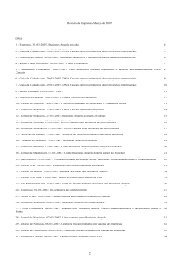Systemic silviculture - DNA Cascais
Systemic silviculture - DNA Cascais
Systemic silviculture - DNA Cascais
Create successful ePaper yourself
Turn your PDF publications into a flip-book with our unique Google optimized e-Paper software.
The Mediterranean forest: conceptual issues<br />
of systemic <strong>silviculture</strong><br />
Orazio Ciancio<br />
Accademia Italiana di Scienze Forestali, Piazza Edison 11 Firenze -<br />
ciancio@aisf.it
The forest plays an important role in making the present<br />
livable and the future possible.
Notwithstanding the progress in the field of ecology and the<br />
evolution of forestry thought,<br />
<strong>silviculture</strong>, forest management and economics are still moving<br />
ahead according to the canons of linear processes and the<br />
mechanistic, reductionist paradigm.<br />
Traditional forest management, based on the theory of the<br />
normal forest and on Rupf’s (1960) wake effect,<br />
Kielwassertheorie, derived from Dietrich’s (1941) “theory of<br />
functions” does not meet the criteria of conservation or recovery<br />
of biological diversity.
Many of the problems of the obvious unsustainability of<br />
traditional forest management come from the idea that wood is<br />
the main, if not sole, useful product of the forest.
In the Mediterranean, for a long time the forest was<br />
considered a wood-producing machine. Even worse, in<br />
some cases it was exploited – and often still is – not as a<br />
renewable resource, but as mine from which to extract as<br />
much as possible in the shortest possible time.
A review of the evolution of forestry thought and scientific and<br />
technical advances shows that the basic trends in <strong>silviculture</strong> can<br />
be traced to four different concepts:<br />
‣financial <strong>silviculture</strong><br />
‣<strong>silviculture</strong> on ecological bases<br />
‣close-to-nature <strong>silviculture</strong><br />
‣systemic <strong>silviculture</strong>
Classic <strong>silviculture</strong>, linear and intensive, is based on the principle<br />
of controlling natural processes through cultivation techniques.
Forest cultivation and management focus on the<br />
volume/regeneration relationship considered as a source of<br />
income and basis for the continuity of production, respectively.<br />
The aim is to guarantee the continuity of production.
With classic <strong>silviculture</strong><br />
productivity, yield and value of the forest are<br />
considered independent of the ecosystem.
The forest cannot be cultivated without keeping in mind the<br />
efficiency and functionality of the ecosystem<br />
The forest is a complex biological system.
<strong>Systemic</strong>, non-linear, extensive <strong>silviculture</strong> based on the principle<br />
of autopoiesis goes well beyond the concept of close-to-nature<br />
<strong>silviculture</strong><br />
With systemic <strong>silviculture</strong><br />
the productivity, yield and economic value of the forest are<br />
dependent upon the ecosystem.
Financial <strong>silviculture</strong><br />
‣ Financial <strong>silviculture</strong> is based on a simplified<br />
management-cultivation system.<br />
‣ It calls for the creation of even-aged, monospecific stands<br />
arranged in age classes.<br />
‣ Rotations are correlated with purely financial criteria<br />
‣ Utilization is by clear-cutting and regeneration is artificial.
Silviculture on ecological bases<br />
Silviculture on ecological bases is a much more complex<br />
management system than financial <strong>silviculture</strong>.
Silviculture on ecological bases calls for the formation of<br />
even-aged, monospecific stands with one, or at most two,<br />
secondary species, with the forest organized in age<br />
classes.
Close-to-nature <strong>silviculture</strong><br />
Close to nature <strong>silviculture</strong> is a management system that has its<br />
roots in tradition and local culture.<br />
It was codified into a system at the end of the XIX century as a<br />
reaction to the excessive artificiality of the financial <strong>silviculture</strong><br />
that was typical in Central Europe.
Close-to-nature <strong>silviculture</strong> aims at the paranatural forest
Currently, close-to-nature <strong>silviculture</strong> is defined as the emulation<br />
of the development cycles of natural forests.
Nature acts through<br />
random events.<br />
Random events cannot be<br />
predicted either as to<br />
recurrence or intensity.<br />
The feedback mechanisms<br />
of the forest system<br />
following these events are<br />
equally unpredictable.
Silviculture, on the other hand, proceeds according to defined and<br />
organized methods, i.e. according to scientifically codified<br />
procedures.<br />
That is why no one form of <strong>silviculture</strong> can be nature-like, if<br />
anything it can be close-to-nature.
The Mediterranean forest and <strong>Systemic</strong> <strong>silviculture</strong><br />
The forest is not merely a group of trees with economic value.<br />
It is an adaptive system that learns and evolves.
Silviculture is the study,<br />
cultivation and use of the<br />
forest, an extremely complex,<br />
autopoietic system that is<br />
capable of autonomous selfperpetuation<br />
and of<br />
accomplishing multiple<br />
functions
The aims of <strong>silviculture</strong> are:<br />
1. maintaining the forest system in balance with the<br />
environment;<br />
2. conserving and increasing biodiversity, and in more general<br />
terms, the system’s complexity;<br />
3. achieving congruency of the management activities with the<br />
other systems with which the forest interacts.
The limits of <strong>silviculture</strong> are defined by the criteria applicable<br />
to the use of renewable resources.<br />
According to these criteria, the utilization and harvesting of<br />
products:<br />
1. should not exceed the rate at which the forest resource<br />
regenerates;<br />
2. should not affect the system’s evolutionary potential;<br />
3. should not reduce biodiversity.
<strong>Systemic</strong> <strong>silviculture</strong> permits the sustainable management of<br />
the forest.<br />
It can be configured with man’s activities as an essential<br />
component of the forest system.<br />
<strong>Systemic</strong>, extensive, non-linear <strong>silviculture</strong> is based on the<br />
principle of autopoesis.
<strong>Systemic</strong> <strong>silviculture</strong> works on behalf of the forest,<br />
according to a cultivation algorithm with the aim of<br />
preserving, conserving, enhancing and favoring<br />
the system’s biological complexity.<br />
It excludes the finalism typical of linear processes that lead<br />
to the normalization of the forest.
In brief, in <strong>silviculture</strong> we must<br />
abandon the positivist approach<br />
that is still dominant in some<br />
academic and research fields<br />
and adopt the approach based<br />
on the scientific attitude of<br />
“trial and error”
The algorithmic concept of systemic <strong>silviculture</strong> makes it possible<br />
to maintain biodiversity and create a new and different relationship<br />
between man and the forest.<br />
It is a relationship in which man is the forest’s referent and not the one<br />
who bends the system to his needs.
At the management level, the application of systemic<br />
<strong>silviculture</strong> requires a change in approach with respect to<br />
classic <strong>silviculture</strong>
Classic <strong>silviculture</strong><br />
<strong>Systemic</strong> <strong>silviculture</strong><br />
Predetermined forest structure<br />
Selection of species<br />
Management unit:<br />
- even-aged forest felling series<br />
- uneven-aged forest compartment<br />
Predefined silvicultural treatment<br />
Cultivation cycle:<br />
-even-aged forest rotation<br />
-uneven-aged forest cutting diameter<br />
Normality:<br />
-even-aged forest age classes<br />
-uneven-aged forest diameter classes<br />
Predetermined allowable cut<br />
Constant and maximum annual product<br />
Simplified forest<br />
Unstructured forest: forest structure undefined<br />
in time and space<br />
Spontaneous mix<br />
Cultivation unit:<br />
the stand<br />
Cautious, continuous, capillary interventions<br />
with the aim of following the ecosystem’s<br />
evolutionary processes<br />
Cultivation cycle:<br />
Undefined<br />
Self-organisation of the forest:<br />
verification of the evolutionary processes<br />
Allowable cut depending on silvicultural<br />
criteria<br />
Periodic product<br />
Conserved and increased complexity
Conclusions<br />
Sustainable management and<br />
conservation of biodiversity<br />
have become the focal points<br />
of forestry.
Classic <strong>silviculture</strong> seeks to respond with technical<br />
measures that have not always enjoyed adequate scientific<br />
support.
In order to give a coherent response to the need for<br />
conserving biodiversity in forest systems, we must encourage<br />
the transition from the technocratic and productivistic view to<br />
the systemic one.<br />
Only by respecting the forest’s self-organization and not<br />
predetermining its structure will it be possible to conserve or<br />
increase biodiversity.
This means moving from classic, linear <strong>silviculture</strong>,<br />
to systemic <strong>silviculture</strong> which, by adopting an eco-centric<br />
standpoint makes it possible to expand the spectrum of values<br />
at stake and base conservation on the intrinsic value of nature<br />
in general and of the ecosystems in particular.
Mediterranean forests, the<br />
fruit of man’s long interaction<br />
with the environment, are rich<br />
in a diversity which today has<br />
a value that goes beyond the<br />
esthetic: it is cultural and<br />
anthropological.
<strong>Systemic</strong> <strong>silviculture</strong> gives man, in his cultural dimension,<br />
the role of an aware member of the biological community.
Only management based on continuous monitoring and<br />
systemic <strong>silviculture</strong> can give a coherent response to the<br />
need for protecting biological diversity that include<br />
diversity produced by human activities as an expression<br />
of culture.
The development that has<br />
taken place in recent years and<br />
the knowledge acquired in the<br />
field of forestry sciences have<br />
led to a change in the<br />
conceptual approaches to the<br />
forest.
In recent years Forest science has moved its boundaries and the<br />
forest is now considered a complex biological system.<br />
This raises ethical problems that are difficult to resolve.<br />
The overall intellectual landscape has changed and the outcome<br />
of this change is a different, vaster and more complete view of<br />
the forest.
According to the theory of<br />
autopoesis, living systems<br />
maintain their specific<br />
identities in spite of<br />
continuous changes in their<br />
components (Maturana and<br />
Varela, 1992).
Since the time of Plato “aesthetics” has inspired a concept of<br />
science in which everything is beautiful, symmetrical and can be<br />
deduced from a few basic principles.<br />
“Aesthetics” in nature becomes science because it derives from<br />
formidable complexities that can also be found at the most<br />
elementary levels.
“Each action is knowledge, and all knowledge is action,” according to<br />
Maturana and Varela (1992).<br />
In <strong>silviculture</strong> this translates into acting “with wisdom” in the sense of<br />
a unity between science and ethics .
Thank you
















